
Tapton Hall is a Grade II listed building situated on Shore Lane in the Crosspool area of Sheffield, England.

Tapton Hall is a Grade II listed building situated on Shore Lane in the Crosspool area of Sheffield, England.
Tapton Hall was built in 1855, on the site of an earlier building known as Tapton Grove, recorded on the 1853 town plan of Sheffield. The date of the construction of Tapton Grove is unknown but it is known that Mary Shore (thus Shore Lane) lived in the house until her death in 1853 at the age of 96. Mrs Shore was the grandmother of Florence Nightingale and the young Florence often stayed at the house. Upon the death of Mrs Shore, the house was bought by Robert B. Mitchell who, within two years, sold the house to the Sheffield steel magnate Edward Vickers.
Vickers’ first action was to demolish Tapton Grove and erect Tapton Hall in its place. He used the architects Flockton & Son and the house was built in the Classical style with Italianate features. In 1867, the house was bought by George Wilson of the family of snuff manufacturers. Wilson paid £3,500 for Tapton Hall, plus £1,424 for the furniture and £218 for the wine left in the cellar. The hall was owned by the Wilson family until the late 1950s, being lived in by George Wilson's son George Kingsford Wilson (1853–1933) and then his grandson George Ronald Wilson (1888–1958). [1]
Soon after the death of George Ronald Wilson in 1958 the hall was purchased by the Masonic Hall Company of Sheffield who had plans to refurbish and extend the building. In 1959, the Masonic Hall Company held a limited competition and invited architectural firms to submit plans for large-scale additions to meet highly specialised needs without detracting from the quality of the house. The competition was won by the Sheffield firm of Hadfield, Cawkwell, Davidson & Partners who restored and renovated the existing house, providing specialised suites of rooms and a new 30,000 square foot extension. The extension, which was completed in 1967, was built in a contemporary style and has been described as “large and uncompromisingly modern”. [2] It comprises two floors and includes four temples, dining rooms and kitchen to serve 360 diners. The extension is constructed in grey brick, ashlar stone slabs and precast concrete cladding. A large abstract concrete mural symbolising the turmoil and chaos of the outside by William Mitchell stands at the members' entrance. [3] [4]
In 1969, the Irish historian Edith Johnston became the first Warden of Sheffield University's Tapton Hall of Residence and she served until 1971. [5]
Today, Tapton Hall is a conference and banqueting centre which hosts weddings, civil ceremonies, corporate events and special occasions. [6]
The building is dominated by a large rounded two-storey bow window consisting of three sashes on each floor. The hipped slate roof is concealed by balustrades. The eastern entrance has a two-storey square porch. The interior has a grand entrance hall with an open-well staircase, moulded segmental arches, modillion cornice and a roof light. [2]

Broomhill and Sharrow Vale — which includes the districts of Broomhill, Broomhall, Crookesmoor, Endcliffe, Sharrow Vale and Tapton Hill — is one of the 28 electoral wards in City of Sheffield, England. The ward was created following the 2015 local government boundary review out of parts of the old Broomhill, Central and Nether Edge wards. It is located in the western part of the city. The population of the Broomhill ward in 2011 was 16,966 people in 5,708 households, covering an area of 2.7 km2. Broomhill & Sharrow Vale is one of the wards that make up the Sheffield Central Parliamentary Constituency.
Crosspool is a suburb of the City of Sheffield, South Yorkshire, England, located 2.5 miles (4 km) west of the city centre. The suburb falls within the Crookes ward of the City of Sheffield. It is a middle class residential area in an elevated position above the Porter and Rivelin valleys and stands at around 660 feet (200 m) above sea level. Crosspool is situated on the A57 road and is the last suburb on that road before the city boundary and open countryside is reached. In 2011 Crosspool had a population of 6,703.
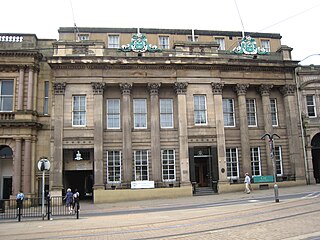
Cutlers' Hall is a Grade II* listed building in Sheffield, England, that is the headquarters of the Company of Cutlers in Hallamshire. It is located on Church Street, opposite Sheffield Cathedral, in Sheffield City Centre.

The Sir Frederick Mappin Building, or more familiarly the Mappin Building, is a Grade II listed building fronting onto Mappin Street, Sheffield, England, part of the University of Sheffield. The building and street are named after Sir Frederick Mappin (1821–1910), the so-called Father of Sheffield University.
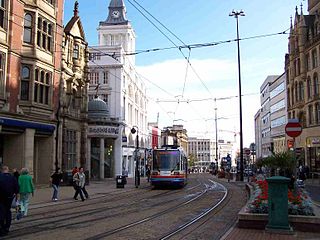
High Street is one of the main thoroughfares and shopping areas in the city centre of Sheffield in South Yorkshire, England, located at the approximate grid reference of SK356874. High Street starts at the Commercial Street, Fitzalan Square and Haymarket junction and runs for approximately 400 metres west to conclude near the Sheffield Cathedral where it forms a Y-junction with Fargate and Church Street. High Street has the traditional wide variety of shops, financial institutions and eating places which are associated with any British town centre.
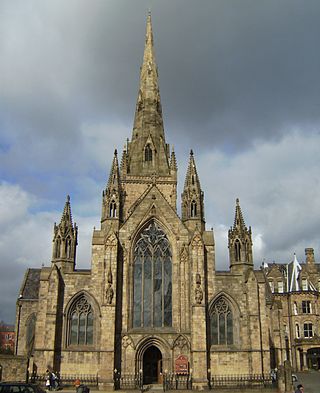
Matthew Ellison Hadfield was an English architect of the Victorian Gothic revival. He is chiefly known for his work on Roman Catholic churches, including the cathedral churches of Salford and Sheffield.

St Vincent's Church is a redundant Roman Catholic church situated on Solly Street at its junction with Hollis Croft in the centre of the City of Sheffield, South Yorkshire, England.

The Globe Works are a former cutlery factory situated in the City of Sheffield, South Yorkshire, England on Penistone Road in the suburb of Neepsend. The Works are a Grade II* Listed Building which in the late 1980s were renovated to provide modern office space. It is part of the Kelham Island Conservation Area.

Endcliffe Hall is a 19th-century, 36-room mansion situated on Endcliffe Vale Road in the City of Sheffield in the suburb of Endcliffe. The hall is situated just over 2 miles (3.2 km) west of the city centre and is a Grade II* Listed building.

The Beehive Works are a purpose-built cutlery works located on Milton Street in the Devonshire Quarter area of Sheffield city centre. The works were built in stages in the second half of the 19th century and are designated as a Grade II* listed building with English Heritage stating that they are of special architectural and historic interest as an examples of buildings associated with Sheffield's metal manufacturing and metal working trades. The works stand adjacent to the Taylor's Eye Witness Works and together they make Milton Street one of the best places to gain an impression of Sheffield’s former cutlery industry.

St Michael's Cemetery is a Catholic burial ground in the Rivelin Valley area of Sheffield, South Yorkshire, England. The cemetery stands on a steep hillside on the south side of Rivelin Valley Road at its junction with Rivelin Road and Hollins Lane.
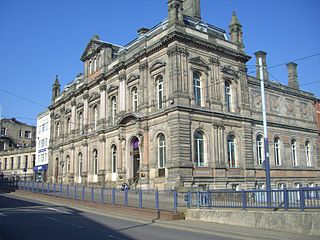
Canada House, formerly known as Panache House, is a Grade II* listed building situated on the northern side of Commercial Street in the centre of the city of Sheffield, South Yorkshire, England. It was built as the head offices of the Sheffield United Gas Light Company in 1874. While the main outlook of the building is out onto Commercial Street there is also a short frontage onto Shude Hill at its eastern end and this designated as 19 Shude Hill.

Banner Cross Hall is an English country house situated on Ecclesall Road South in the Banner Cross area of Sheffield, England. The hall is a Grade II listed building which is now the main headquarters of Henry Boot PLC, the Sheffield-based property and construction company.

Oakes Park is a privately owned, historic park land in the green-belt area of south Sheffield. It contains 15 private homes as well as a 17th-century English country house which now operates as The Oakes Holiday Centre, a Christian, residential activity centre for young people between the ages of 8 and 18. It is set in extensive grounds which make it very difficult to be seen by the general public. It is situated on Norton Lane in the suburb of Norton within the City of Sheffield in England. The house is a Grade II* listed building, as are several other buildings and features.

Norton Hall is an English country house situated on Norton Church Road in the suburb of Norton in Sheffield, England. For most of its history it has been a private residence, in its latter history it has been used as a NHS hospital, a private hospital and has now been converted into high quality apartments. It is a Grade II* listed building.

Parkhead Hall, formerly Parkhead House and The Woodlands, is an English country house situated in the City of Sheffield in South Yorkshire. The hall is a grade II listed building and is located in the suburb of Whirlow close to the junction of Ecclesall Road South and Abbey Lane. The hall is difficult to view for the general public, being surrounded by high walls and housing, although a glimpse of its northern side can be seen from Ecclesall Road South.

Fulwood Hall, is an English country house situated on Harrison Lane in the suburb of Fulwood in Sheffield, England. It is a Grade II listed building. The hall stands in a lofty position on the north side of the Mayfield Valley at a height of 270 metres. The hall is referred to as Fullwood Hall on old maps and the gate to the hall uses this spelling with two Ls.
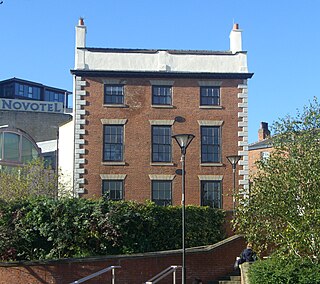
Leader House is a Georgian townhouse located on Surrey Street in the city centre of Sheffield, England. It overlooks Arundel Gate and is a Grade II listed building.

Frank Tory and Sons were an English family firm of Sheffield based architectural sculptors whose work enhances some of the city's finest late 19th century and early 20th century buildings. Apart from stone carving the family also worked in wood, marble, bronze and fibrous plaster. The firm operated from the early 1880s until the 1950s and consisted of Frank Tory and his twin sons Alfred Herbert and William Frank.

John Dodsley Webster FRIBA (1840–1913) was an English architect who designed more than 15 churches in Sheffield in various Gothic styles, usually working to a tight budget. His work also included hospitals and commercial buildings, small country houses and private houses. All his known work was carried out in the South Yorkshire and North Derbyshire area except for a chapel and school built in Coventry.